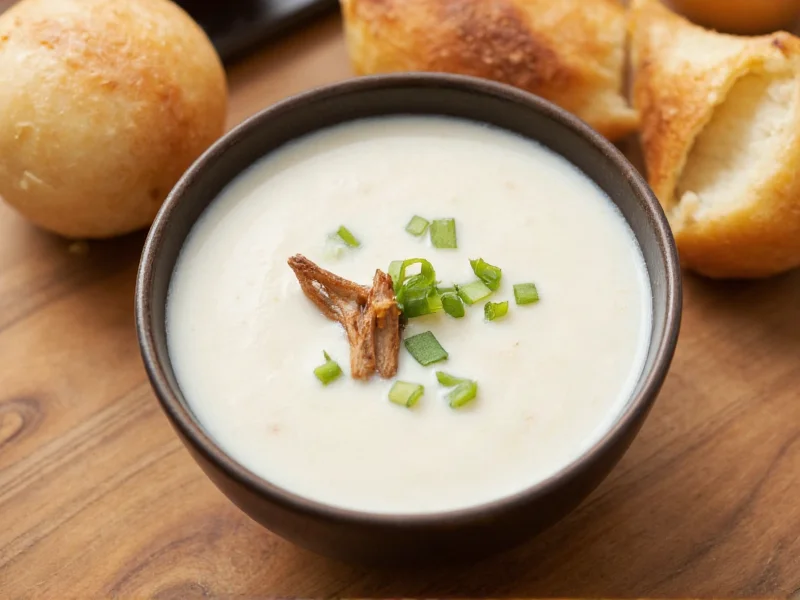Creating perfect milk soup requires understanding both technique and ingredient compatibility. Unlike broth-based soups, milk soup demands gentle handling to maintain its creamy consistency while developing rich flavors. This versatile preparation appears in culinary traditions worldwide, from Indian makai ka dhoodh to Polish barszcz biały, demonstrating remarkable adaptability across cultures.
Diverse Milk Soup Variations Across Cultures
Milk-based soups feature prominently in global cuisines, each with distinctive preparation methods and cultural significance. Understanding these variations helps home cooks appreciate the technique's versatility while avoiding common preparation mistakes.
| Cultural Variation | Key Ingredients | Distinctive Technique |
|---|---|---|
| Indian Makai Ka Dhoodh | Corn, milk, ginger, green chilies | Raw corn kernels ground with milk before gentle simmering |
| Polish Barszcz Biały | Beetroot, milk, mushrooms, hard-boiled eggs | Beetroot fermented for sourness before milk incorporation |
| Mexican Sopa de Leche | Milk, rice, cinnamon, sugar | Rice cooked directly in milk with aromatic spices |
| Ethiopian Dabo Kolo | Milk, barley, spices | Dry roasted barley added to warm milk |
Essential Ingredients for Perfect Milk Soup
The foundation of exceptional milk soup begins with quality ingredients. Whole milk (3.25% fat) provides optimal texture, though alternatives like coconut milk work for dairy-free versions. Key complementary ingredients include:
- Starch thickeners: Rice, oats, or potatoes create natural viscosity without requiring roux
- Aromatic vegetables: Leeks, fennel, or mild onions add depth without overpowering
- Acidic components: A splash of lemon juice or fermented ingredients used sparingly
- Protein additions: Cooked chicken, tofu, or legumes for heartier preparations
Professional chefs emphasize ingredient sequencing matters significantly. Always heat milk separately before incorporating other elements, never adding cold ingredients directly to hot milk.
Step-by-Step Preparation Guide
Follow this professional technique for foolproof milk soup every time:
- Warm milk gently in heavy-bottomed pot to 160°F (71°C), well below boiling point
- Prepare complementary ingredients separately (sauté vegetables, cook grains)
- Cool additional ingredients to near room temperature before combining
- Temper milk by gradually adding small amounts of warm complementary mixture
- Maintain final soup temperature below 180°F (82°C) for serving
- Add salt only at the end to prevent protein coagulation
Preventing Common Milk Soup Problems
Curdling represents the most frequent challenge when preparing milk soup. Understanding the science behind dairy proteins helps avoid this issue:
Milk proteins (casein and whey) coagulate when exposed to temperatures above 180°F (82°C) or sudden pH changes. To prevent curdling when adding acidic ingredients:
- Dilute acids (lemon juice, vinegar) in a small amount of milk first
- Ensure all ingredients are at similar temperatures before combining
- Maintain consistent, moderate heat throughout preparation
- Consider using scalded milk, which has more stable proteins
Nutritional Profile and Dietary Adaptations
Milk soup provides valuable nutrition when properly prepared. A standard serving (1 cup) of basic milk soup contains approximately:
- 150-200 calories depending on added ingredients
- 8-10g protein from dairy sources
- Significant calcium and vitamin D
- Adaptable for various dietary needs with simple modifications
For lactose-intolerant individuals, lactose-free milk or coconut milk alternatives work well. Vegan versions substitute plant-based milks while adding nutritional yeast for umami depth. Low-fat versions maintain creaminess by incorporating pureed cauliflower or potatoes as natural thickeners.
Serving and Storage Recommendations
Milk soup performs best when served immediately after preparation. If storing leftovers:
- Cool rapidly by placing pot in ice water bath
- Store in airtight container for up to 3 days
- Reheat gently over medium-low heat, never boiling
- Stir frequently during reheating to prevent skin formation
For optimal texture when reheating, add a small splash of fresh milk to restore creaminess. Avoid freezing milk-based soups as the dairy separates upon thawing.
Expert Tips for Culinary Success
Professional chefs recommend these advanced techniques for perfect milk soup:
- Use non-reactive cookware (stainless steel or enameled cast iron)
- Add a pinch of baking soda to counteract natural milk acidity
- Incorporate fresh herbs at the very end for vibrant flavor
- Create layered flavors by roasting vegetables before adding to milk
- Finish with a touch of butter for enhanced mouthfeel











 浙公网安备
33010002000092号
浙公网安备
33010002000092号 浙B2-20120091-4
浙B2-20120091-4